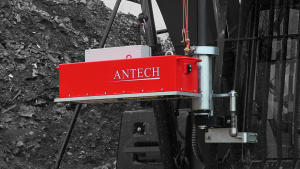The ANTECH G3101-0100 Soil Monitoring System (SMS) is a compact, maneuverable assay system for the in-field assay and sampling of soil as part of land remediation and decommissioning projects. With a large volume Sodium Iodide detector, the Soil Monitoring System can provide spectroscopic analysis of a sample, using ANTECH’s Spectrum Analyser software package.
- Sensitive in-field sampling for immediate spectroscopic analysis or gross gamma assessment of soil, sand etc.
- Easy for single-person operation meaning wide spread, rapid sampling and measurement can be carried out.
- Shielded large volume plastic scintillator detector for high efficiency and accuracy measurements.
- Optional GPS sample positioning for contamination distribution mapping.
Benefits
- Optional GPS integration for time-stamped sampling location.
- Detachable tray with off-track wheels for quick sample acquisition.
- Manually driven detector travel for simple in-field operation with low maintenance.
- Portable Operation.
- Temperature controlled detector for energy calibration stability.
Features
-
Description
The G3101-0100 Soil Monitoring System consists of two main units; the Assay Docking Station and a Sample collection tray.
The Assay Docking Station provides a moveable trolley holding all hardware and electronics for the assay process, including a 2″ x 4″ x 16″ thermally controlled Sodium Iodide detector, embedded controller and battery bank for remote operation. The Docking Station is mounted on two rugged tyres for “off-road” operation, with a push handle. The detector is housed within a shielded enclosure mounted to two low-friction slide rails to allow the detector to be moved from the idle position over the sample to carry out an assay. Micro-switches are used to clear the detector buffers to trigger an assay, and also to assess the speed of movement over the sample to ensure adequate counting time.
The flat bedded sample tray or ‘Sample Barrow’ provides an easily manoeuvrable holder for a sample of soil, sand etc. to be loaded into before an assay. Once loaded, the sample barrow can be wheeled into position with the assay trolley, and once docked, a measurement can begin. Once completed, the tray can be removed and the sample returned or discarded. The barrow is designed with a flat base to enable a flat sample is analysed, thus minimising the errors in the correction for attenuation of the sample. The tray is made from stainless steel to both ensure no damage occurs to the hardware, but also to provide background shielding for the detector whilst measuring. It is mounted on rugged, off-road tyres to ensure it is easy to move across rough terrain. An optional integrated GPS module in the Sample Barrow allows for logging of the location of samples to develop a profile of the land being sampled.
The G3101-0100 is operated via a rugged Operator Tablet with all software loaded onto it. The Operator Tablet uses wireless communication to talk to the detection system and perform the analysis. The Spectrum Analyser software can provide a spectroscopic analysis of the sample based on configured regions of interest, or can perform a gross gamma assessment of the sample for a go/no-go result. The Operator Tablet also connects with the Sample Barrow GPS module to provide a position log for the sample which can be used to create a distribution map of contamination.
-
Specifications
Detector2" x 4" x 16" Na(Tl)IShieldingDetector housing lined with 2mm lead and 1mm tin.Tray size0.1 m³ at a uniform depth of 150mm 3.53 ft³ at a uniform depth of 5.91"Operating Voltage (V)24VdcAnalysis SoftwareANTECH Spectrum Analyser







